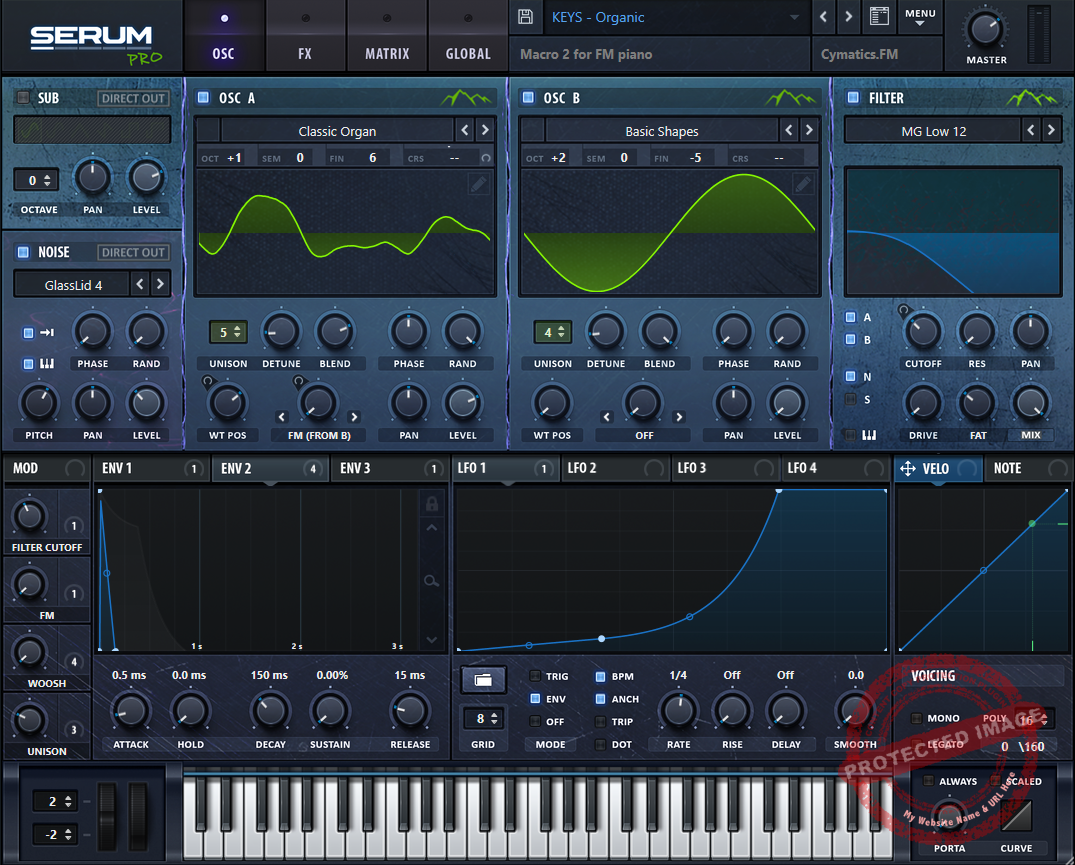Serum delivers phenomenal sound, powerful modulation, and intuitive design, making it a favorite for sound design and electronic music. While CPU-intensive, its features and workflow make it a top-tier wavetable synth worth every penny or the rent-to-own option.
Price
Pros
- Clean, alias-free oscillators for professional sound
- Intuitive drag-and-drop modulation system
- Flexible wavetable creation and editing options
- Built-in effects, including the powerful multiband compressor
- Extensive preset library for quick inspiration
Cons
- High CPU usage on complex patches
- Steeper learning curve for beginners
- Limited modulation slots in the matrix
- No built-in arpeggiator or sequencer
Xfer Serum VST synth is one of the most versatile and “self-sufficient” synthesizers, and I will be sharing my experience with it so you can decide if it’s worth your money or not.
I still remember when I was introduced to Serum for the first time. It first came across as a super-complicated wavetable synthesizer that I had seen in tutorials for creating sounds from scratch. I just wanted to learn the fundamentals so I could also do creative sound design and build synthesizers, bass, pads, and other instruments from scratch.
It took me a while to grasp it completely, but once I did, there was no looking back. I started relying on it for all my sound design work and always stayed on the hunt for new preset libraries and sounds. My relationship with synthesizers suddenly improved with this plugin. And now, after 6 years of using it, I still use it as my primary synthesizer, especially for electronic genres.
Yes, I combine it with various Kontakt libraries, Omnisphere, and some other synths, too, but a huge portion of my workflow is dependent on this only. But what is it about Serum synth that still makes me stick to it? Moreover, if I were to start again in 2025, is there something I would do differently?
I will answer all these questions for you and give you my review of the Xfer Records Serum.
What Does Xfer Serum VST synth Do?
Serum is a wavetable synthesizer designed to create, shape, and manipulate sounds. At its core, it allows you to generate sounds using wavetables, which are essentially collections of waveforms that you can morph and manipulate.
Wait, let me explain in simple words now. It works like any other synthesizer, which generates audio from oscillators and then uses filters, modulators, and effects to tweak that sound. In Serum, these oscillators source their sounds from wavetables. What are wavetables? Imagine having a collection of waveforms (or sounds) in a single unit. You can select any one waveform from this collection by using the wavetable position parameter.
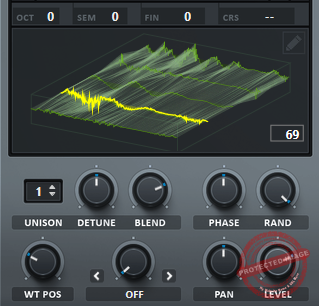
Features
Serum is built on a modular approach to sound design, where each component, like oscillators, filters, modulators, and effects, helps you shape your sound.
Oscillators: The Sound Generators
At the heart of Xfer Serum are its oscillators, which are responsible for generating the raw audio that forms the foundation of your sounds. Serum’s oscillators are known for their high-quality sound and alias-free performance.
- 2 Primary Wavetable Oscillators:
For both of these oscillators, you get various useful controls like Unison, Detune, Blend, WT position, and others. By activating unison, you can duplicate the oscillator’s voices and spread them across the stereo field, creating a thicker, more spacious sound.
The number of voices can be adjusted, and when combined with Detune, which slightly shifts the pitch of each voice, you can achieve anything from subtle chorusing to massive, supersaw-style leads.
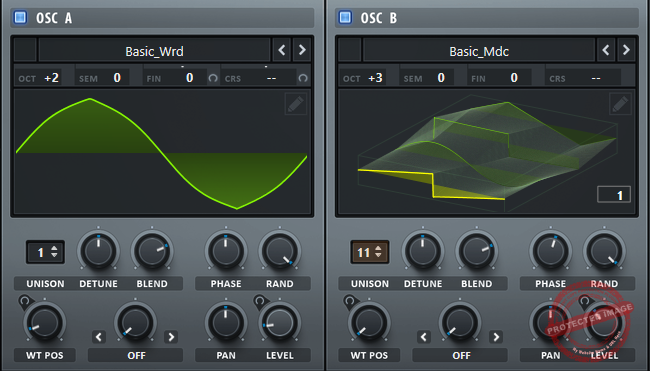
For instance, in a trance track, I’ll often set 8 voices with moderate detune for a lush and energetic sound. The Blend control works in tandem with unison and detune, allowing you to adjust the balance between the centered voice and the detuned voice. By fine-tuning this parameter, you can control how prominent the detuned voices are in the mix.
When designing a pad, I might use a higher blend to emphasize the detuned voices and enhance the atmospheric qualities of the sound. Next, Phase and Rand (random phase) can introduce variation and control the starting position of the oscillator’s waveform.
The point is that these are some very elaborate controls that can give your sounds a great starting point. Like, if you’re going for a particular type of bass sound, you must select the right wavetable or waveform that will give you the right fundamentals for your sound. Thereafter, you can use these tools to sculpt it further and make it more suitable.
- Sub Oscillator
This is a simple oscillator that provides clean, fundamental tones like sine, triangle, or square waves. It’s perfect for adding depth and body to basslines or reinforcing the low end of your sound. Here, you also get simple octave, volume, and pan controls.
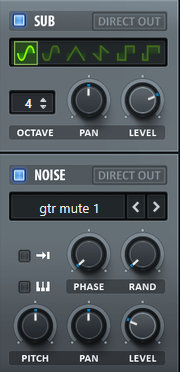
- Noise Oscillator
More than just white noise, this oscillator includes a library of unique sounds like vinyl crackle, wind, or custom samples that you can layer to add texture or atmosphere.
Filters: Sculpting the Sound
The filter section in Xfer Serum synth is like a sculptor’s chisel, helping you carve out tonal characteristics that define your patch. Serum offers a wide range of filter types, from classic low-pass, high-pass, and band-pass filters to more experimental options like flanges, combs, and formants.
For example, when designing a warm pad, I often use a low-pass filter to remove the high frequencies, creating a smoother, more mellow tone. For aggressive basslines, a high-pass filter paired with resonance can add sharpness and presence.
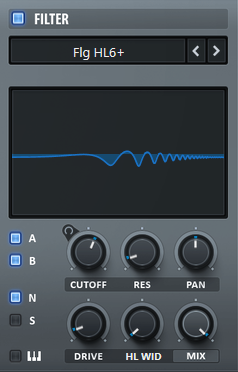
One of my favorite features is the dual filter routing, which lets you assign different oscillators to different filters or run them in parallel. This is perfect for layering sounds, like adding a metallic comb filter to one oscillator while keeping another oscillator clean and warm.
Serum’s filters also have key tracking, ensuring the tonal character of the filter moves with the pitch of your notes. This is invaluable for expressive leads or dynamic pads that stay consistent across the keyboard. Combine that with modulation from LFOs or envelopes, and you can create truly evolving soundscapes.
Modulators: Adding Motion and Expression
Serum’s modulators are where your sounds come to life. They introduce movement, dynamics, and complexity, turning static patches into evolving, expressive creations. The modulation system is incredibly intuitive, thanks to its drag-and-drop functionality. You can simply grab a modulation source and drop it onto the parameter you want to control.
- LFOs (Low-Frequency Oscillators)
Serum VST provides 4 customizable LFOs that can shape almost any parameter in your sound. For example, I’ve used an LFO to slowly sweep the wavetable position on a pad, creating a dreamy, evolving texture. You can also design intricate rhythmic patterns for plucks and basslines by tweaking the LFO shape and rate.
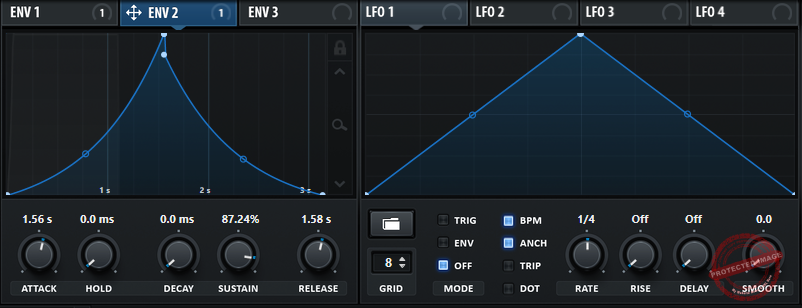
- Envelopes
In addition to the amp envelope, which controls volume dynamics, Serum synth vst offers three additional envelopes for modulating other parameters. These are ideal for creating sharp attacks for percussive plucks or smooth swells for pads. For instance, I often assign an envelope to control the filter cutoff, adding punch to bass sounds or subtle rises to leads.
- Macros
The 4 macro knobs in Serum are a game-changer, especially for live performance and automation in your DAW. Macros let you control multiple parameters with a single knob. For instance, I’d, in some of my presets, set up a macro to simultaneously increase filter cutoff, LFO rate, and reverb mix, transforming a sound from dark and subdued to bright and expansive with one tweak.

- Global Modulation Matrix
For advanced users, Serum’s modulation matrix allows precise control over modulation assignments. Here, you can fine-tune how sources like LFOs, envelopes, or macros influence their targets. For example, I use the matrix to subtly modulate both the pitch and phase of an oscillator, creating a gritty, analog-like instability.
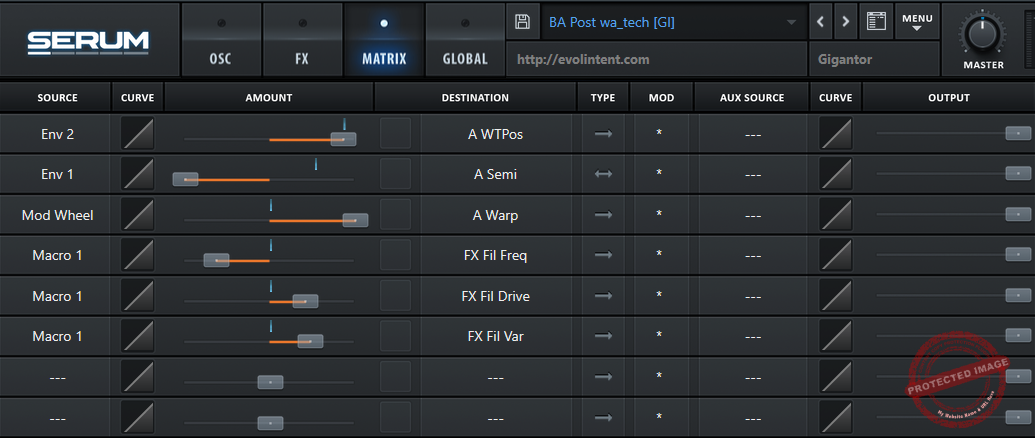
Effects
The effects section, in my opinion, is an underrated Serum and is not talked about enough. I even go to the extent of using the Serum FX plugin on other sounds, too. I especially love its multiband compressor. Xfer Records has integrated its multiband compressor, OTT, into the plugin.
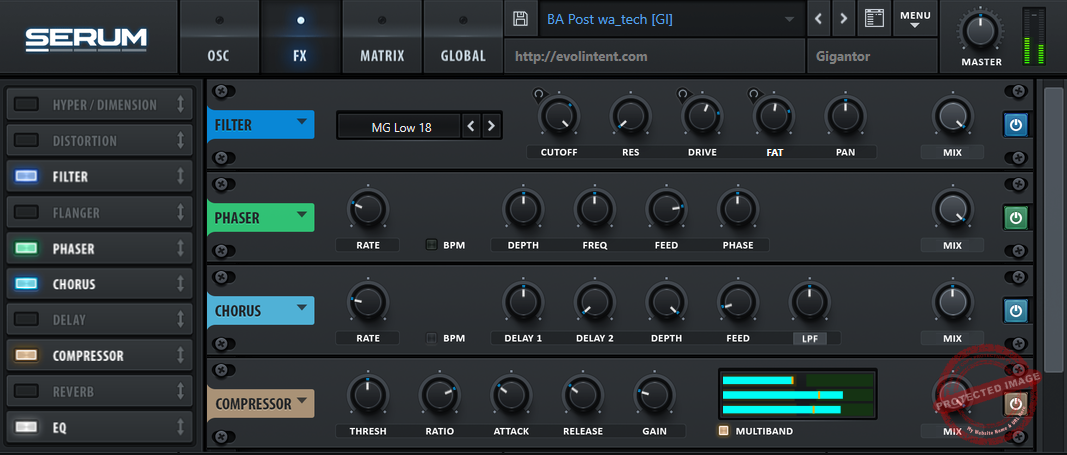
| Effect | Description | Use Cases | Key Features |
| Reverb | Adds space and atmosphere to sounds. | Lush pads, dreamy textures, or subtle room reflections for leads. |
Multiple modes (room, hall, plate); adjustable decay, size, and mix.
|
| Delay | Creates rhythmic echoes and spacious delay effects. | Syncopated rhythms, ping-pong effects, or long atmospheric echoes. |
Sync and ping-pong modes; adjustable feedback, time, and filter.
|
| Distortion | Adds warmth, grit, or aggressive character to sounds. | Growling basses, warm leads, or experimental sound design. |
Multiple modes (Tube, Soft Clip, Diode, etc.); blend and drive controls.
|
| Chorus | Adds shimmer and stereo width to sounds. | Thickening pads, enhancing leads, or creating lush textures. |
Adjustable delay time, depth, and feedback for fine-tuning width and motion.
|
| Flanger | Produces sweeping, metallic sounds by modulating pitch. | Creating swirling effects, metallic textures, or experimental soundscapes. |
Adjustable depth, rate, and feedback; stereo spread control.
|
| Phaser | Adds swirling and shifting tonal qualities. | Ethereal pads, dynamic leads, or evolving soundscapes. |
Control over frequency, depth, and feedback; fully modulatable.
|
| Compressor | Enhances dynamics and brings sounds forward in the mix. | Punchy leads, tight basses, or brightening dense sounds. |
Multiband mode is similar to OTT; it has an adjustable threshold, ratio, and mix.
|
| EQ | Shapes tonal balance by boosting or cutting frequencies. | Cleaning low-end muddiness, brightening leads, or creating unique sweeps. |
Flexible high/low shelf and midband control; fully modulatable for dynamic effects.
|
| Hyper/Dimension | Adds stereo width and subtle motion to sounds. | Expanding basslines, thickening leads, or creating spacious textures. |
Hyper-thickens sound subtly; Dimension creates wide stereo effects with adjustable mix.
|
Interface and Workflow
What I love about Xfer Serum VST synth is its thoughtfully designed interface and smooth workflow, which make sound design feel less like a technical process and more like a creative journey. Everything you need, oscillators, modulators, filters, and macros, is well laid out in a single window.
This streamlined setup eliminates the need to navigate multiple tabs or menus, ensuring you can focus entirely on shaping your sounds. The interface has a visually engaging design that provides real-time feedback, whether you’re tweaking a wavetable or modulating a parameter.
The plugin is also fully resizable, allowing you to adjust the interface to your screen size or personal preferences, a feature that’s often overlooked in other synths. And you can also choose and install different skins to get a suitable aesthetic for yourself.
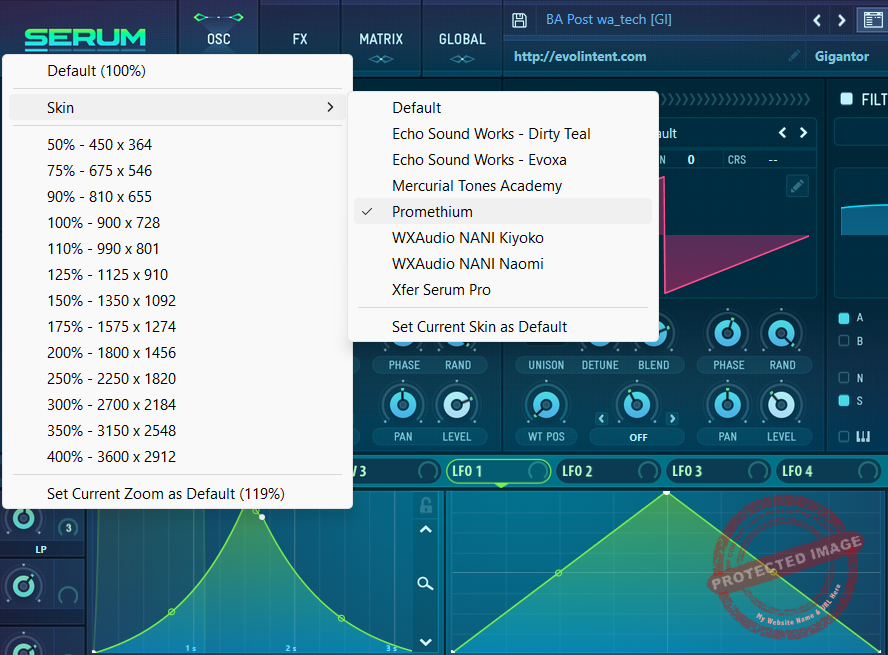
One of the standout features is the drag-and-drop workflow, which adds decent intuitiveness to the design process. Assigning modulation sources like LFOs or envelopes is as simple as dragging them onto the parameter you want to control. This ease of use makes even complex modulation setups feel natural and approachable, encouraging experimentation without the frustration of more rigid systems.
The FX window is another highlight of Serum’s interface. Not only does it provide high-quality effects like reverb, delay, distortion, and the famous multiband compressor, but it also allows you to shuffle the order of the effects by dragging them around. This modular approach to effects routing lets you experiment with different chains, resulting in endless sonic possibilities.
However, it’s worth noting that Serum can be a little heavy on your system, especially when running multiple instances with high polyphony or oversampling enabled. Speaking of oversampling, Serum offers up to 4x oversampling for high audio quality, which is great for maintaining clarity during sound design but can strain less powerful systems.
For those who like to fine-tune their instruments, Serum includes options for mono, legato, and portamento modes, giving you precise control over your note transitions and playability. You can also change the global tuning or pitch tracking from the standard A4=440 Hz, a rare but valuable feature for composers working outside traditional Western tuning systems.
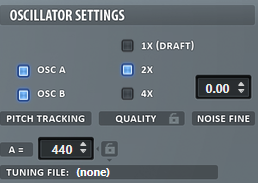
Additionally, velocity mapping provides even more expressive control, enabling dynamic responses to how hard or soft you play a note. This, combined with the drag-and-drop modulation and an intuitive layout, makes Serum a joy to use, whether you’re a beginner exploring presets or an advanced producer creating sounds from scratch.
First Impressions and Sound
When I first heard Serum synth, the sound really stood out to me with its clean, detailed, and polished tones. The oscillators never get rough and muddy when I push them hard. Whether I’m working on a soft evolving pad or a solid bassline, I know Serum will deliver that professional sound I need.
I love how easy it is to experiment. The wavetables feel like a playground for sound design, and I like the drag-drop modulation! For instance, dragging an LFO to a filter cutoff does nothing—no extra steps, no fuss. What keeps me coming back to it is the quality of sound and the ease of use.
And I love how much control Serum gives me over the details. I can go into the wavetables and sculpt the sound to fit what I need when I work on a patch. Sometimes, I’ll use the warp modes to add a bit of grit or movement, and other times, I’ll keep things smooth and simple. It’s flexible without feeling overwhelming, which is a balance I really appreciate.
The effects section is another highlight for me. I often rely on the built-in reverb and that famous multiband compressor to polish my sounds right inside the plugin. It saves me time and keeps my workflow focused. Serum VST just feels like a tool I can trust to handle anything, whether I’m making subtle textures or bold, upfront sounds.
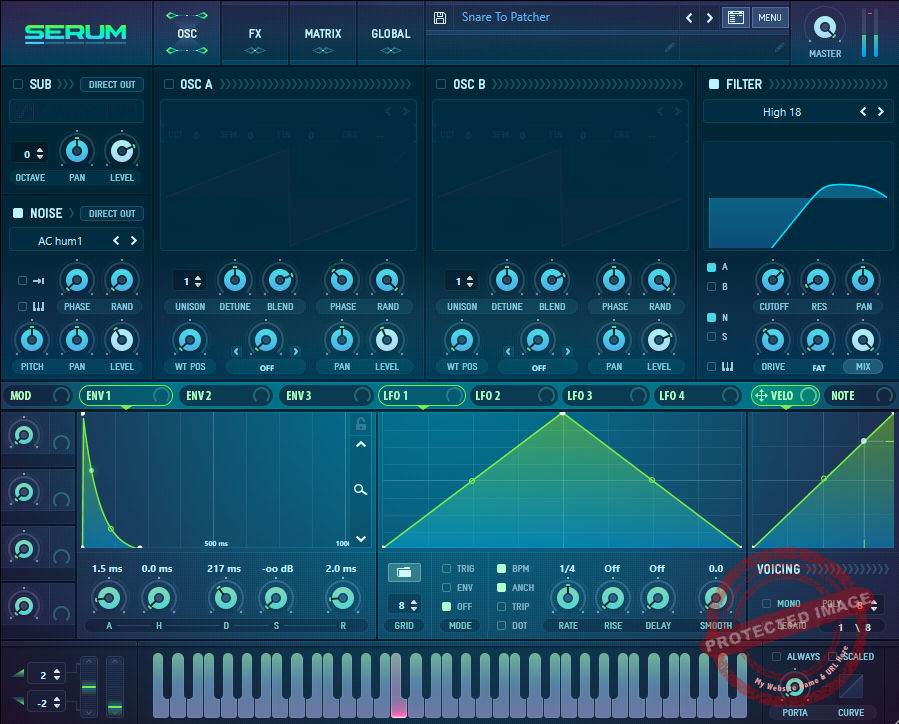
Is it beginner-friendly?
Serum VST is not beginner-friendly, but for how complicated it is, it is one of the most sorted-out synths with the most straightforward interface, with everything aligned well in a single place. It’s been six years since I learned about this synth, and I am still discovering new things about it.
When I first opened Serum, it felt like stepping into a maze of knobs, waveforms, and modulators. For a beginner, it can seem overwhelming at first glance. Serum’s interface is sleek and inviting, but it’s packed with tools that might intimidate someone new to sound design. However, once you spend a little time with it, you’ll realize how intuitive it really is.
For beginners, preset tweaking is a great entry point. Serum comes with a solid library of presets, so you can start by modifying existing sounds before diving into creating patches from scratch. There’s also a wealth of tutorials, courses, and forums dedicated to Serum, making it easier to learn than ever.
The Price / Cost (How Much does Serum cost?)
If you prefer outright ownership, you can purchase the full version of Serum for $189. If you’re not ready to invest in the full price upfront, Serum’s rent-to-own plan via Splice is a fantastic option. For just $9.99/month over 19 months, you can pay it off gradually while using the full version of the plugin. There’s also a 3-day free trial, so you can test it out before committing.
Here’s a feature and pricing analysis table of Serum compared to some of the other similar synths in the market.
| Synthesizer | Price | Features | Best For |
| Serum (Xfer Records) | $189 (one-time) or $9.99/month (Splice rent-to-own) | – Wavetable synthesis with real-time visual feedback – Advanced modulation (drag-and-drop, Global Matrix) – High-quality alias-free oscillators and effects (incl. OTT compressor) – Custom wavetable import and extensive preset library |
Producers focused on electronic genres and detailed sound design
|
| Massive X (Native Instruments) | $199 (or included in Komplete bundles) | – Flexible wavetable engine with multiple oscillator modes – Advanced routing for modulation – Rich effects and granular/additive synthesis tools – Steeper learning curve than Serum |
Advanced users needing deep customization for cinematic and experimental sounds
|
| Vital (Matt Tytel) | Free (Basic), $25 (Plus), $80 (Pro) | – Open-source wavetable synth with free tier – Drag-and-drop modulation with visual feedback – Spectral warping for evolving textures – Fewer effects and presets compared to Serum |
Budget-conscious producers seeking a versatile Serum alternative
|
| Omnisphere (Spectrasonics) | $499 (one-time) | – Hybrid synth combining sample-based and wavetable synthesis – Massive library of over 14,000 sounds – Deep modulation options and granular synthesis – Resource-intensive |
Composers and producers needing expansive sound libraries for cinematic or hybrid music
|
| Phase Plant (Kilohearts) | Subscription at $9.99/month | – Modular synthesis with customizable signal flow – Combines wavetable, granular, and sample-based synthesis – Built-in Snapin effects for tailored sound processing – High learning curve but unmatched flexibility |
Sound designers and producers requiring extreme modularity
|
| Diva (u-he) | €179 (one-time) | – Analog-modeled synthesizer recreating vintage hardware sounds – High-quality filters and oscillators emulating classic synths – CPU-intensive but unmatched analog warmth – Limited wavetable or modern sound design capabilities |
Producers seeking rich analog tones for classic and retro genres
|
If you’re on a budget, Vital may provide a compelling free option with many of Serum’s features. If you’re looking for modular flexibility, Phase Plant may stand out with its customizable workflow. Omnisphere also delivers an unmatched library of ready-to-use sounds if you prefer cinematic or hybrid compositions.
Meanwhile, Diva definitely offers that characterful analog warmth for retro and vintage-inspired genres, and Massive X caters to more advanced sound designers with its deep modulation and routing options.
In terms of value, Serum’s rent-to-own model ensures accessibility without upfront investment, making it a smart choice for beginners and professionals alike.
Compatibility
Serum is compatible with all major operating systems and DAWs:
- Windows: Windows 7 SP1 or later.
- Mac: macOS 10.11 or later.
- Supports 64-bit VST 2.4, AU, or AAX-compatible host software.
Final Thoughts
Even in 2025, I would prefer to buy or rent Xfer Serum VST synth over any other wavetable synthesizer. That’s because it has a flexible drag-and-drop workflow that I really prefer, all the features I need in a synth, a great-sounding FX section, and the best preset libraries available for a synth.
Given how popular Serum is, you can easily find plenty of tutorials, resources, and additional sounds that you can add to your library and expand your sound palette. The best part about 2025 is that you can do monthly rentals and rent them to own soon, only for about $10.
Hope this article was helpful. Thank you for reading.

Shaurya Bhatia is a versatile content writer with a strong focus on music production, composition, and the technical aspects of audio engineering. With a deep understanding of the music industry, Shaurya specializes in creating insightful and engaging content around music production techniques, songwriting, audio engineering, and the intersection of technology and art in music. He loves to create content for musicians, audio engineers and sound designers.

